Cement is a mixture of different constituents and acts as the main constituent in concrete, Egyptians first manufactured Cementing materials by burning gypsum. And then Romans & Greeks used cementing materials obtained by burning limestone.
Romans found the fact that volcanic ash & tuff, when mixed with limestone, gives superior mortar which has a high quality. (The early signs of making concrete.) Since then, they started experimenting by adding different materials in the mix to increase the workability of mortar.
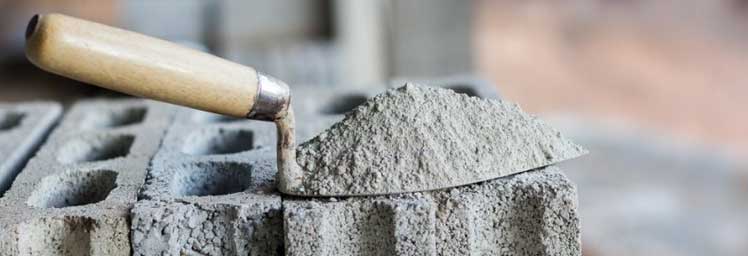
Different Types Of Cement – Definition, Properties And Uses
There are over ten different types of cements that are used in construction purposes, and they differ by their composition and are manufactured for different uses.
These are rapid-hardening cement (RHC), quick-setting cement (QSC), low-heat cement (LHC), sulphate-resisting cement (SRC), blast furnace slag cement (BFSC), high-alumina cement (HAC), white cement (WC), coloured cement (CC), pozzolanic cement (PzC), air-entraining cement (AEC), and hydrophobic cement (HpC). RHC has increased the lime content compared to the Portland cement (PC).
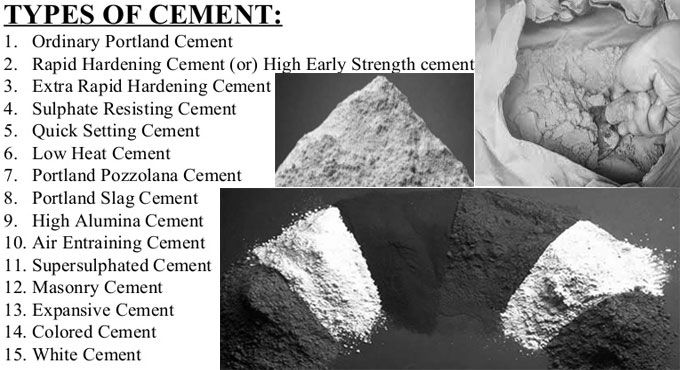
Followings are the types of cement:
- Ordinary Portland Cement (OPC)
- Portland Pozzolana Cement (PPC)
- Rapid Hardening Cement
- Quick Setting Cement
- Low Heat Cement
- Sulphate Resisting Cement
- Blast Furnace Cement
- High Alumina Cement
- White Cement
- Colored Cement
- Air Entraining Cement
- Expansive Cement
- Hydrophobic Cement
Low Heat Cement: This type of cement is used in large mass concrete works such as dams and large piers, where the heat generated by the hydration of the cement can cause cracking. Low heat cement generates less heat during the hydration process and helps to prevent cracking.
Sulphate Resisting Cement: This type of cement is used in situations where the concrete will be exposed to high levels of sulphates, such as in marine environments or in soils with high sulphate content. It is formulated to resist the expansion and cracking caused by the reaction of sulphates with the cement.
Blast Furnace Cement: This type of cement is made by grinding together a mixture of blast furnace slag, limestone, and gypsum. It is known for its low heat of hydration and high resistance to sulphates and acids. It is commonly used in marine construction, industrial floors and pavements, and precast concrete products.
Colored Cement: This type of cement is made by adding pigments to the cement during the manufacturing process, which allows the concrete to be colored. It is commonly used in decorative concrete, architectural concrete, and terrazzo flooring.
Air Entraining Cement: This type of cement is formulated to produce concrete that is more resistant to freezing and thawing. It is made by adding air-entraining agents to the cement during the manufacturing process. It is commonly used in cold weather construction and in concrete exposed to freeze-thaw cycles.
1. OPC Or Ordinary Portland Cement
Ordinary Portland Cement (OPC): This is the most common type of cement and is used in a wide range of construction projects. It is made by grinding together a mixture of limestone, clay, and iron ore. OPC is available in three grades, namely 33, 43, and 53 based on the strength achieved after 28 days of curing.
Read More About Ordinary Portland Cement (OPC).
In usual construction work, Ordinary Portland Cement is widely used. This is the most common type of cement which is extensively used. It has good resistance to cracking and dry shrinkage but less resistance to chemical attack. OPC is not suitable for the construction work which is exposed to sulphates in the soil.
Ordinary Portland cement is available in following types – 33 grade, 43 grade & 53 grade.
The grade represents the strength of cement at 28days. 33grade = 33N/mm2
The composition of Ordinary Portland Cement:
- Argillaceous or silicates of alumina (clay and shale)
- Calcareous or calcium carbonate (limestone, chalk, and marl)
Uses of Ordinary Portland Cement
- It is used for general construction purposes.
- It is also used in most of the masonry works.
2. Portland Pozzolana Cement or PPC
Portland Pozzolana Cement (PPC): This type of cement is made by grinding together Portland cement clinker and a pozzolanic material, such as fly ash or rice husk ash. PPC is known for its low heat of hydration and high sulphate resistance. It is commonly used in mass concrete works like dams, bridges, and marine structures.
Pozzolans are natural or synthetic materials that contain silica in reactive forms. It reacts with calcium hydroxide generated by hydrating cement to form additional cementations materials when it is finely divided.
The pozzolana is a material which is formed due to the volcanic eruptions. It is a siliceous material having about 80% clay in it. Pozzolana cement is manufactured by mixing 30% of pozzolana to Ordinary Portland cement clinkers. This type of cement is used in construction of dams and weirs.
The composition of Portland Pozzolana Cement:
- OPC clinker
- Gypsum
- Pozzolanic Materials (Fly ash, volcanic ash, and Calcined clay or silica fumes.)
Uses of Portland Pozzolana Cement
- PPC is usually used in hydraulic structures, marine structures, construction near the seashore, dam construction etc.
- It is also used in pre-stressed and post-tensioned concrete members.
- As it gives a better surface finish, it is used in decorative and art structures.
- It is also used in the manufacture of precast sewage pipes.
3. Rapid Hardening Cement (RHC)
Rapid Hardening Cement: This type of cement is similar to OPC but with a higher content of tri-calcium silicate and tri-calcium aluminate. As a result, it sets quickly and gains strength rapidly. It is often used in projects with tight schedules, such as road construction, or in precast concrete products.
High-Early-Strength cement is also known as Rapid Hardening Cement. It is generated in proportion to raw materials with such changes. So that Rapid Hardening Cement produced attains maximum strength with-in 24-72 hours.
When finely grounded Tri-calcium silicate (C3S) is present in OPC with higher content, it gains strength more quickly than OPC. This type of OPC is called Rapid Hardening Cement. It’s initial Setting Time 30 minutes and Final Setting Time 600 minutes.
Uses of Rapid Hardening Cement
- Rapid hardening cement is mostly used where rapid construction is needed like the construction of pavement.
- It also gives high strength.
4. Quick Setting Cement
Quick Setting Cement: Quick setting cement is one that sets more quickly than OPC but maintains the same strength. The amount of gypsum in this formula is decreased. This type of cement is designed to set and harden quickly, making it useful in emergency repairs or in situations where the concrete needs to be ready for use soon after being placed.
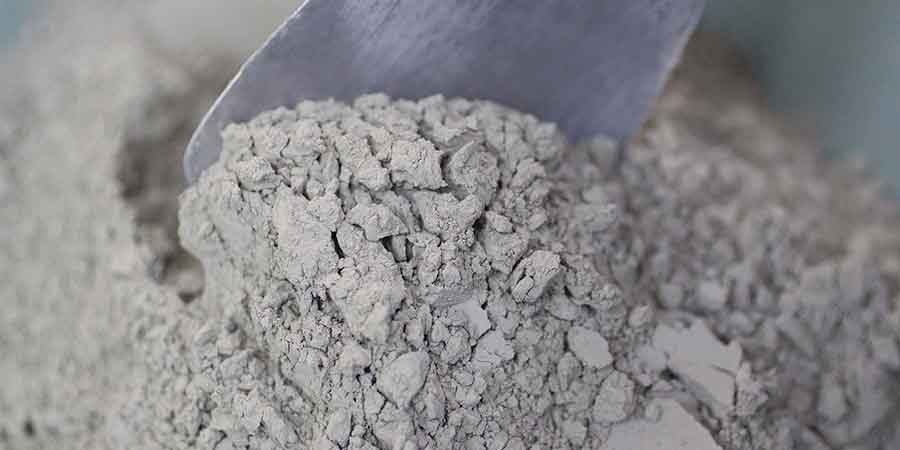
It is used in repair of RCC structures, underwater concreting, and cold weather concreting. This type of cement is used for constructions that require a quick setting, such as underwater structures and in chilly and rainy climates.
5. Low Heat Cement
Quick Setting Cement
Quick setting cement is the cement which sets in a very short time. The initial setting time is 5 minutes and the final setting time is 30 minutes. The composition of Quick Setting Cement:
- Clinker
- Aluminium sulphate (1% to 3% by weight of clinker)
- The aluminium sulphte increase the hydration rate of silicate.
Uses of Quick Setting Cement
- It is used in underwater construction.
- It is also used in rainy & cold weather conditions.
- It is used a higher temperature where water evaporates easily.
- Used for anchoring or rock bolt mining and tunneling
Low Heat Cement
It is a spatial type of cement which produce low heat of hydration during setting. This type of cement is manufactured by lowering the C3S content and increasing the C2S content. It possesses less compressive strength than ordinary Portland cement. It has less lime content than OPC. This type of cement is mostly used in the construction of retaining walls and it is strictly not suitable for thin concrete structures.
Some chemical composition of Ordinary Portland Cement is modified to reduce the heat of hydration. The chemical composition of low heat cement:
- A low percentage (5%) of tricalcium aluminate (C3A)
- A higher percentage (46%) of declaim silicate (C2S).
Uses of Low Heat Cement
- It is used for the construction of dam’s large footing, large raft slabs, and wind turbine plinths.
- It is also used for the construction of chemical plants.
Sulphate Resisting Cement
Sulphet resisting cement is used to resist sulphet attacks in concrete. Due to the lower percentage of Tricalcium aluminate, the production of calcium sulpho-aluminates gets reduced. It is manufactured by keeping the percentage of C3A below 5%.
This type of cement is used where the structure is prone to severe sulphate attacks(alkaline conditions) such as construction in the foundation of soil, marine conditions, sewage treatment tanks.
Uses of Sulphates resisting Cement
- Construction in contact with soils or groundwater having more than 0.2% or 0.3 % g/l sulphate salts respectively.
- Concrete surfaces subjected to alternate wetting and drying such as bridge piers, concrete surface in tidal zone, apron, Building near seacoast.
- Effluent treatment plans, Chimney, Chemical industries, water storage, sumps, drainage works, Cooling towers, Coastal protective works such as sea walls, breakwaters, tetrapods, etc.
Blast Furnace Cement
Portland cement clinker and granulated blast furnace slag are intergrinded to make blast furnace cement. Maximum 65 percent of the mixture could be comprised by blast furnace slag. Blast Furnace cement is cheaper than Ordinary Portland cement. it is manufactured by inter grinding of OPC clinker and blast furnace slag. Blast furnace slag cement develops low heat of hydration and has less early strength.
Uses of Blast Furnace Cement
- It is highly sulphate resistant
- Frequently used in seawater construction.
High Alumina Cement
High Alumina cement is obtained by mixing calcining bauxite (it’s an aluminium ore) and ordinary lime with clinker during the manufacture of OPC. In which the total amount of alumina content should not be lesser than 32% and it should maintain the ratio by weight of alumina to the lime between 0.85 to 1.30.
This type of cement has rich alumina content about 35% which helps in gaining ultimate high strength within a short period. This type of cement is used where a structure is subjected to the action of sea water, chemical plants and furnaces.
Uses of High Alumina Cement
- It is used where concrete structures are subjected to high temperatures like workshop, refractory, foundries etc
- It also used where the concrete is subjected to frost and acidic action.
White Cement
White cement is quite similar to Ordinary Portland Cement except for color. Amounts of iron oxide and manganese oxide are low in White Cement. It is expensive then OPC so not economical for ordinary work.
Uses of White Cement
- It is usually used in decorative work.
- It can also use for traffic barriers, tile grouts, swimming pools, roof tiles patching materials and terrazzo surfaces.
Colored Cement
To make 5 to 10 percent of suitable pigments are grinded with OPC. Types of pigments are selected according to the desired color. Colored cement is also known as Colcrete. It is manufactured by adding coloring pigment to the OPC. it is used in joining tiles.
Uses of Colored Cement
- Colored cement is used for different decorative work.
Air Entraining Cement
It is seen that entrainment of air or formation of gas bubbles while applying cement increases resistance to frost action, fire, scaling and other similar defects. Air-entraining cement is a special type of cement which entrains tinny air bubbles in concrete.
It is produced by grinding minute air entertaining materials with clinker by adding some resinous materials e.g. vinsol resin to ordinary portland cement.
When the water in concrete gets frizzed due to low temperature, it expands. When air-entraining cement, the air voids in concrete provides space for water to expand without cracking concrete. But this type of cement does not provide high strength in concrete.
Uses of Air-Entraining Cement
- Especially it is used in areas where the temperature is very low.
- It also resists Sulphet attack.
- It is used where the de-iceing chemical is used.
Expansive Cement
In the hydration process, the expansive cement expands its volume. It can be possible to overcome shrinkage loss by using expansive cement.
This type of cement is manufactured by adding stabilizer which stabilizes the cement to expand. This can be achieved by adding 8-20% of sulphoaluminate & 15% of stabilizer to the ordinary Portland cement clinker.
Concrete made up of OPC shrinks while setting due to loss of free water. Concrete also shrinks continuously for a long time. Cement used for grouting should not shrink or change volume for this, we use expansive cement. the expansive cement doesn’t show any volume change after hardening.
There are three types of expansive cement:
- K Type expansive cement
- M Type expansive cement
- S Type expansive cement
K Type expansive cement
Raw materials of these types of cement
- Portland cement
- Anhydrous tetracalcium trialuminate sulfate (C4A3S)
- Calcium sulfate (CaSO4)
- Lime (CaO).
M Type Expansive Cement
Raw materials of these types of cement
- Portland cement clinkers
- Calcium sulfate.
S Type Expansive Cement
Raw materials of these types of cement
- Portland cement clinkers
- Calcium sulfate (High amount)
- Tricalcium aluminate (C3A) (High amount)
Uses of Expansive cement
- It is used in the construction of the pre-stressed concrete component.
- It is also used for sealing joints and grouting anchor bolt.
- In the construction of different hydraulic structures, this type of cement is used.
Hydrophobic Cement
To resist the hydration process in the transportation or storage stage, clinkers are grinded with water repellent film substance such as Oleic Acid or Stearic Acid. These chemicals form a layer on the cement particle and do not allow water to mix and start the hydration process.
When cement and aggregate are thoroughly mixed in the mixer, protective layers break and start normal hydration with some air-entrainment which increases workability.
Hydrophobic Cement is manufactured by grinding ordinary Portland cement clinker with water oleic acid or stearic acid. These acids forms as a water repellent film around the cement particle which increases the shelf life of cement.
The formed around each grain of cement reduces the rate of deterioration of the cement during long storage, transport, or under unfavourable conditions. The film is broken out when the cement and aggregate are mixed together at the mixer exposing the cement particles for normal hydration.
Uses of Hydrophobic Cement
- Usually, it is used in the construction of water structures such as dams, spillways, or other submerged structures.
- It is also used in the construction of underground structures like tunnel etc.
4. Ultra High Strength Cement
In advanced countries, at the production stage itself, an ultra-high early strength cement is generated by separating the finest fraction (above 700 m2/kg) from the rapid hardening cement.
Using special devices called the cyclone air elutriator, this is performed. Such cement is used for early concrete with very high strength.
8. High Alumina Cement
High Alumina Cement: High Alumina Cement is created by combining calcined bauxite, lime, and clinker during the production of OPC. This type of cement is made by grinding together bauxite and limestone. It is known for its high resistance to chemical attack and high heat of hydration. It is commonly used in refractory linings, furnace and kiln construction, and in high temperature applications.
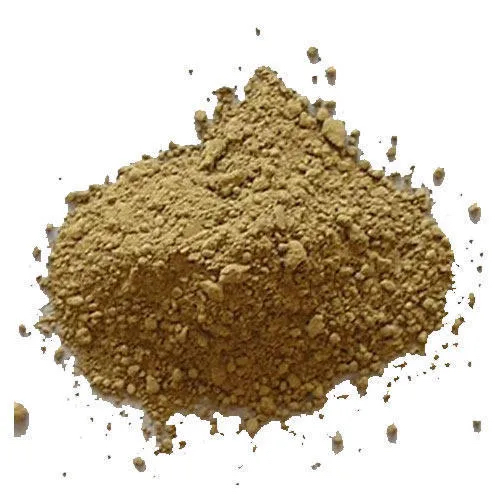
For cement to be considered High Alumina Cement, the total alumina content must be at least 32%, and the weight ratio of alumina to lime must be between 0.85 and 1.30. It is commonly used in structures that are exposed to high temperatures, such as workshops, refractories, and foundries.
9. White Cement
White Cement: This type of cement is made using raw materials that have a low iron and manganese content, which results in a cement that is much whiter in color. It is commonly used in decorative concrete, architectural concrete, and terrazzo flooring. This kind of cement is produced from raw materials devoid of iron and oxide and needs to have a high proportion of lime and clay.
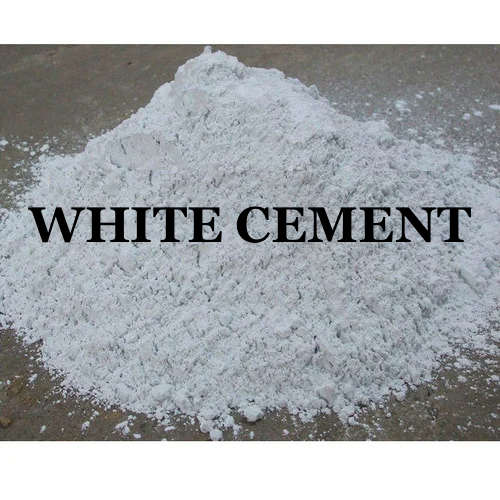
It is expensive and is used for architectural purposes, including precast curtain walls and facing panels, terrazzo surfaces, etc. It is also used for interior and exterior decorative work, including exterior renderings of buildings, facing slabs, flooring, ornamental concrete products, garden paths, swimming pools, etc.
What are the four general types of cement?
Purpose of having high lime content is to attain high strength in early days. It is used in concrete when formwork is to be removed early.
Since hardening of cement is due to the formation of CaCO3 by absorbing atmospheric CO2 by CaO, increased CaO results in increased CaCO3 formation even at the early stage to result in rapid hardening.
QSC is produced by adding a small percentage of aluminium sulphate as an accelerator and reducing the amount of gypsum used with fine grinding. This cement is used when the work is to be completed very quickly as in static and running waters.
LHC has reduced the amount of C3A, which is used to produce massive concrete constructions like gravity dams. LHC has compressive strength to heat of the hydration ratio of at least 7 at the age of 13 weeks.
The usual wt. ratio of CaO to SiO2 is between 0.8 and 1.5, but Al2O3 wt.% is less than 10%.
This is prepared by grinding the CaO, SiO2, and Al2O3 materials, melting the mixture, quenching the melt, and grinding the quenched matter to have mainly amorphous material of the above composition.
Alumina is a hydratable material and reduced alumina gives reduced hydration to produce less heat of hydration. This is important in the construction of large structures to avoid possible thermal cracking during concrete setting.
Sulphate attack on concrete is a chemical breakdown mechanism, where sulphate reacts with C3A and/or Ca(OH)2 components of the hardened cement forming ettringite, which is hexacalcium aluminate trisulphate hydrate [(CaO)6(Al2O3) (SO3) 32H2O = C6ASH32].
Sulphate ions can react with C3A and/or Ca(OH)2 in hardened concrete in the presence of water forming gypsum.
These newly formed ettringite and gypsum crystals occupy empty spaces of concrete, and as they grow, they tend to damage the paste by cracking. The most important parameters determining the sulphate attack are C3A, C3S/C2A ratio, and C4AF.
It has been reported that the addition of pozzolonic admixtures such as fly ash reduces the C3A content of cement when sulphate is present in water and soil used; in places like canal linings, culverts, retaining walls, and siphons, it is important to use SRC. SRC is prepared by maintaining C3A content below 6%.
BFSC is prepared by grinding the clinkers with ∼60% slag. BFSC resembles properties of the Portland cement and is used for works in which economic considerations are predominant. HAC is obtained by melting a mixture of bauxite and lime and grinding the mixture with the clinker.
Since it contains high alumina content, it is rapid-hardening cement with initial and final setting times of about 3.5 h and 5 h, respectively. HAC is used in works where concrete is subjected to high temperatures, frost, and acidic conditions. WC is prepared from raw materials free from iron oxides and oxides of other transition metals such as Cr, Mn, Cu, V, and Ti.
The colouring effect takes the order Cr2O3 > Mn2O3 > Fe2O3 > V2O3 > CuO > Ti2O3. As such, the amounts of these transition metal ions, particularly Cr3+, Mn3+, and Fe3+, should be minimized to form white cement. Usually, Cr2O3, Mn2O3, and Fe2O3 are kept below 0.003%, 0.03%, and 0.35%, respectively, in the clinker. Cheap quarried raw materials usually contain Cr, Mn, and Fe.
For example, lime stones and clays usually contain 0.3–1% and 5–15% Fe2O3. Keeping Fe2O3 below 0.5% is desirable to make WC, and as such, kaolin and sand are used instead of other clays in making WC.
The abrasiveness of sand particles with size <45 µm also ensures less wearing of chrome-steel grinding mill used to grind raw materials, which would otherwise contaminate the mixture with Fe and Cr. Usually, sand is ground separately using ceramic grinding media to avoid chromium contamination.
WC is costly and hence used in aesthetic applications such as precast curtain wall and facing panels and terrazzo surface.
Contrary to WC, CC is prepared by deliberately adding mineral pigments to cement. CCs are widely used in decorative works on floors. Iron oxides are used to get red, yellow, and black base colours, and several mixed colours such as browns-terracotta-tuscany-sepia-beach.
Standard green and blue pigments are chrome oxide and cobalt aluminium oxide, respectively. TiO2 is the usual white pigment. PzC is prepared by grinding the pozzolanic clinker with the Portland cement. It is used in marine structures, sewage works, and for laying concrete under water such as in bridges, piers, and dams.
AEC is produced by adding air-entraining agents that are surfactants such as alkali salts of wood resins, synthetic detergents of the alkyl-aryl sulphonate type, calcium lignosulphate derived from the sulphite process in paper making, and calcium salts of glues and other proteins obtained in the treatment of animal hides, animal and vegetable fats, oil and their acids, wetting agents, aluminium powder, and hydrogen peroxide, during the grinding of the clinker.
They are added in 0.025–0.1% in either solid or liquid form. At the time of mixing, AEC produces tough, tiny, discrete noncoalescing air bubbles of 10–500 µm in diameter in the body of the concrete. These bubbles can compress to some extent, and hence, they can absorb stress created by freezing.
HpC is prepared by adding water-repellent chemicals [26]. They are prepared particularly for use in high-rainfall regions to prevent water absorption during storage.
Particles of HpC are coated with nonpolar substances, usually by adsorbing oleic acid, stearic acid, and so on, to cement particles.
When adsorbed, these surfactant molecules self-assemble by coordinating with surface cations through their carboxylic acid groups thereby allowing the nonpolar hydrocarbon chain to extend from the particles.
When a water drop falls on them, they are stuck on hydrocarbon chains and stay as spherical particles as does by the lotus leaf. The cement particles are then not wetted, and water drops roll off when slightly slanted.
These hydrophobic coatings prevent the attacks by chloride and sulphate ions, and hence, they resist to deterioration of concretes by these ions.